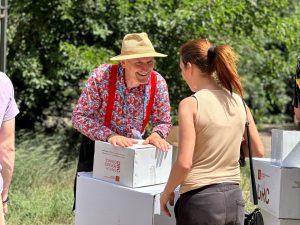Unit 4: Volunteering in Wartime
Section 1: What is volunteering?
1.1 What’s at stake?
The current global situation is characterized by political tensions and armed conflicts that result in the forced mass displacement of people.
According to the data presented in the Global Report on Internal Displacement 2024 (GRID, 2024) “the total number of people living in internal displacement increased by 51% over the past five years, reaching a record high of 75.9 million people across 116 countries at the end of 2023.”
Most people are displaced by war and violence (68.3 million), and 7.7 million by disasters.
Most of these displacements occur in low- and middle-income countries, making people in situations of internal displacement even more vulnerable.
Forced displacement requires a rapid and combined response that includes:
- evacuation,
- basic humanitarian assistance (water, food, essential items),
- accommodation,
- social assistance,
- medical and psychological support.
However, in military conflicts, societies are faced with the need to solve a whole set of problems at once, primarily related to the defense of the state’s territorial integrity and independence.

Studies of societies in the context of natural disasters show that spontaneous assistance is often one of the most effective and rapid responses to a situation (Twigg and Mosel, 2017). It can build people’s social capital and strengthen their position to improve public policies and decisions (Hedman, 2009, Gilmartin, 2023).
In such conditions, the role of local civil initiatives, international humanitarian organizations, and volunteerism increases significantly.
Given this context, there is a growing attention to volunteering, which is often seen as a meaningful civic response to various social challenges directly or indirectly related to war and forced displacement.
At the same time, volunteering, due to its fluid structure, flexibility of activity, and dependence on the personal characteristics of the actors involved, remains a complex object of study.
‘Pure’ theoretical definitions of volunteering are difficult to apply to real life, where volunteering has many different variations.
1.2 How is volunteering usually defined?
Definition: Volunteer
If you look for a dictionary definition of ‘volunteer’, you will find the following:
“A person who does something, especially helping other people, willingly and without being forced or paid to do it” (Cambridge Dictionary)
Exercise 4.1
Look up three other dictionary definitions of ‘volunteering,’ ‘volunteer,’ and ‘voluntary’.
- How many of the following features are given:
- Unpaid
- Compulsory
- Willing(ly)
- Unforced
- Independent
- Meaningful
- Altruistic
- Free
- Remunerated
- Mandatory
- Non-profit
- Personal
- Socially useful
- Optional
- Which of the above would you apply to the concept of volunteering?
1.3 Looking at the definition of volunteering in more detail
Voluntary work refers to non-profit activity including unpaid, self-organized or institutionally organized, socially oriented work.
This means a personal, non-profit commitment that is connected with a regular, project- or event-related expenditure of time, which could in principle also be carried out by another person and could potentially also be paid for.
This definition refers to three essential characteristics of voluntary work, which should also be taken into account by research:
- Voluntariness: The activity is free, autonomous, independent.
- Non-profit status: Voluntary work constitutes a not-for-profit system that adds value to society.
- Meaningful activity: Voluntary work is a meaningful activity.
Exercise 4.2
Think about the implications of the above and answer the following questions:
- What is the relationship between voluntary work and paid work?
- How can voluntary service and its added value—e.g., as social capital—be grasped without merely thinking about monetization?
- What may be the underlying motives for voluntary work?
- What can we learn from voluntary work about work in general and the system of gainful employment in particular?
Further reading:
Güntert, S.T., Wehner, T., Mieg, H.A. (2022). Definition of Volunteer Work and a Model of Volunteer Activity. In: Organizational, Motivational, and Cultural Contexts of Volunteering. Springer Briefs in Psychology. Springer, Cham. https://doi.org/10.1007/978-3-030-92817-9_1
1.4 What do we understand by the ‘altruistic’ nature of volunteering?
Altruism is a concept often associated with volunteering. Yet the ‘altruistic’ nature of volunteering itself also has many variations at the level of people’s everyday experiences. It is important for us, at this point, to get a deeper understanding of possible motivations for volunteering.
From the perspective of the individual volunteer these may include other motives that are difficult to characterize as purely altruistic:
- the perception of volunteering as a career stepping stone;
- volunteering as a useful line on a resume or entry on a CV;
- the perception of volunteering as a socially approved and common practice in society;
- the desire of members of privileged groups to maintain a balance of justice through volunteering and to mitigate and justify their privileged position in society.
States and corporations can pursue their goals by encouraging people to volunteer:
- Volunteering encourages people to ‘be like everyone else’;
- Motivating people to volunteer can be part of the whole system of social work in society and thus socially expected rather than voluntary;
- Volunteering can be an instrumental approach deployed by the state for those with precarious labor market positions to engage in unpaid activities, playing on their hopes about possible improvements in the future.
You have now completed Section 1 of Unit 4. Up next is Section 2: What are the main theoretical challenges in the study of volunteering?
